In this article, we review important terms for selecting louvers and dampers. We will go over what they mean in HVAC and why they are important to building an efficient HVAC system!
Important Terms in HVAC Design
Louvers and dampers seem like simple devices, but there are a lot of things to consider. And you will need to understand certain technical terms to make the best decisions. The key to building an HVAC system is finding the balance between airflow, energy use, and requirements: get the necessary amount of air through the system with the least amount of energy, while meeting the building's requirements.
This balance starts by understanding the important terms involved in choosing louvers and dampers.
Starting a new HVAC project? Looking for dampers? Consider adding the 517-518 series control damper from Arrow United Industries! Let's work together on your next project.
Free Area
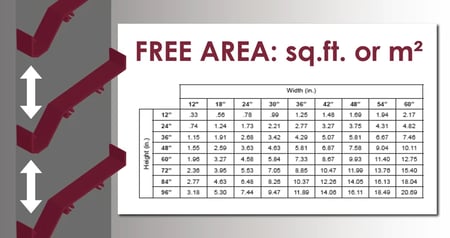
Free area refers to the amount of open space between the blades of a louver or damper. More free area typically means better air performance. However, certain blade features will reduce the free area of the damper or louver, such as drainable channels and catches. Free area can be measured as square feet or meters of free area, or as a percentage of the louver's total area.
For adjustable louvers and dampers, the free area is measured with the blades rotated to the fully open position. Free area will increase with the size of the louver or damper.
Pressure Drop
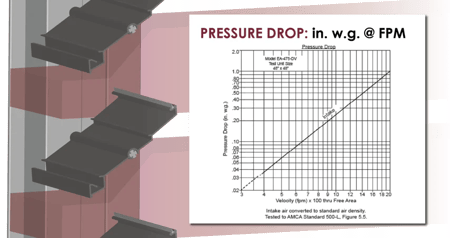
Pressure drop is the loss of pressure and velocity as air moves across a louver or damper, measured in inches of water gauge at a given air velocity in feet per minute (in. w.g. @ FPM). In the case of louvers and dampers, this refers to the drop in pressure as air passes through the free area between open blades.
All louvers and dampers will cause pressure drop. Read "Air Performance and Keeping the Flow", a quick Condenser article on maintaining air performance. Here are a few pointers:
- Search for equipment with the least pressure drop that still meets the application's requirements, such as severe weather protection.
- Louvers with blade catches and drain channels will incur more pressure drop than flat, featureless blades. The same is true of control damper blades.
- Lower pressure drop is considered better for air performance.
Beginning Point of Water Penetration
Exclusive to louvers
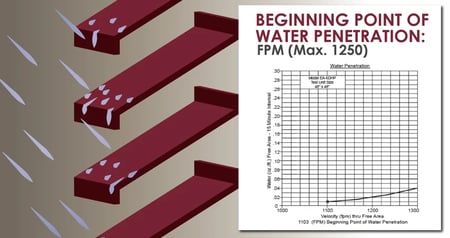
The beginning point of water penetration is the point, measured in air velocity, when water will infiltrate a louver. This term is often shortened to "water penetration". Most louvers will protect the opening from light rainfall, but certain louvers are specifically designed to protect against water infiltration. The key to protecting an opening is finding louvers with a higher beginning point of water penetration than its desired face velocity.
Louvers with a high beginning point of water penetration can intake greater air velocities and maintain their protection against rainfall. The beginning point of water penetration is measured by tests simulating light rainfall. These tests are performed in accordance with AMCA Standard 500-L. Data from these tests are plotted on a curved line graph and presented on a louver's submittal.
A higher beginning point of water penetration will provide a greater level of protection. Read how AMCA-approved laboratories perform these tests with our Newsstand article: AMCA Testing - Water Penetration. Severe weather louvers are specially designed to prevent water penetration at higher air velocities. These are typically referred to as wind driven rain louvers.
Wind Driven Rain
Exclusive to louvers
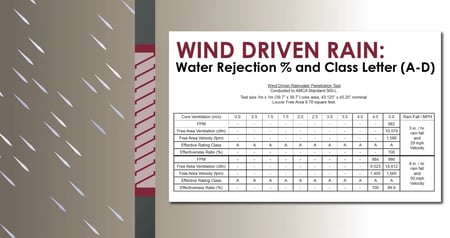
Wind driven rain refers to a louver's ability to reject rainfall during a severe weather event. Tests for wind driven rain measure how much water is rejected by the louver’s blades at a given air velocity under simulated severe weather. These tests are conducted in accordance with AMCA Standard 500-L for wind driven rain testing. Read more about wind driven rain testing on the MCDLG Newsstand.
Metrics for wind driven rain tests are typically listed at various airflow rates and each data point is accompanied by a percentage of test water rejection and a letter rating: Class A ratings are the best, rejecting 99% or more simulated rainfall during testing. To review a louver's capabilities, Review the wind driven rain data listed on the louver's submittal.
Static Pressure
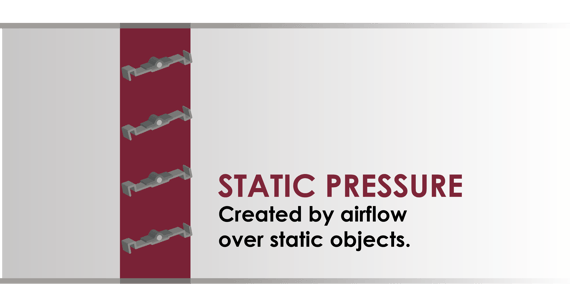
Static pressure is the pressure created as air flows across or through objects in an airstream. This creates a pressure differential from one side of the object to the other. All louvers and dampers will cause a certain amount of static pressure, even with their blades in the fully open position.
Static pressure will increase as more air flows through, and excessive static pressure can make it difficult to pass air through an HVAC system. It is important to minimize static pressure where possible to minimize the resistance to airflow.
Dynamic Pressure
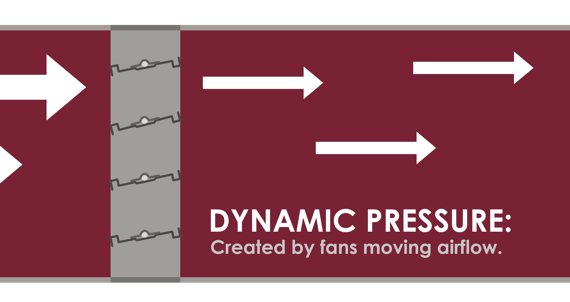
Dynamic pressure is the pressure exerted to move air. For an HVAC system, fans will create the dynamic pressure required to drive air through the ductwork. Dynamic pressure must exceed the static pressure in the duct for air to move through. In "Balanced Flow", we discuss the relationship between static and dynamic pressures, and how to minimize pressure drop in your system.
Efficient HVAC systems can maintain adequate dynamic pressure using the least amount of power possible. This is the key to maintaining an energy efficient and cost-effective HVAC system.
Max Static Pressure
The maximum amount of static pressure allowed in a duct for a damper to safely operate. The damper will create static pressure and this pressure will increase as the airflow rate increases. Every damper will have a maximum rated static pressure. If static pressure exceeds the damper’s limit, then the damper is not guaranteed to open or close.
Even if the damper does work in these conditions, you risk damaging the damper’s components. Review the project's specifications to ensure your dampers will operate safely in their ducts.
Duct Velocity
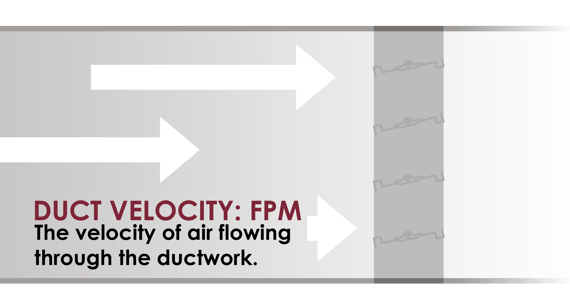
Duct velocity is the velocity of air flowing through a duct, typically measured in feet per minute (FPM). Your project will have different velocity requirements for different ducts, depending on where they are in the system and their intended purpose. Increase the speed of the system’s fans to increase duct velocity. However, excessive static pressure will make it difficult to achieve the desired duct velocity.
A good rule of thumb is to keep ducts clear of unnecessary obstructions, so that increases in duct velocity will require less power. Make sure the dampers in your duct can operate by comparing the duct’s velocity with the damper’s max face velocity.
Face Velocity
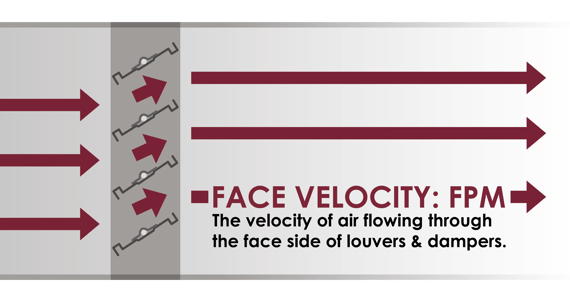
The velocity of air flow as it passes into the front side of a louver or damper, measured in FPM. Air flow will generate pressure drop as it passes through free area, which affects air velocity.
The face velocity of the louver or damper will help you determine its potential pressure drop. You should also make sure the louver’s face velocity will not exceed its beginning point of water penetration. This will ensure the louver works for your building and protects the opening from rain infiltration.
Max Velocity
The maximum air velocity allowed for a damper to safely operate. The damper’s max velocity refers to face velocity, or the velocity of air passing through the face of the damper. The damper is not guaranteed to open or close once the face velocity exceeds this limit.
Consult the specifications documents for your building project. With these, you can determine the duct velocity of the surrounding ductwork to gauge what you will need for the max velocity of the damper.
Air Leakage
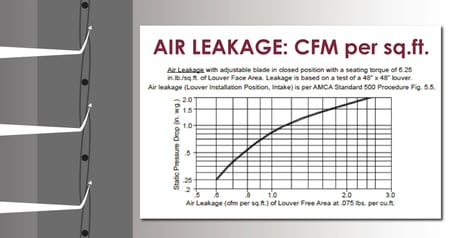
Air leakage is the amount of air that passes through the blades of a closed adjustable louver or damper, at a specific air velocity. No louver or damper will be airtight, but even a small amount of leakage can create problems when driving air through the system.
For louvers and airflow dampers, air leakage is measured through testing performed in accordance with AMCA Standard 500-L, for louvers, and AMCA Standard 500-D for dampers. Choose adjustable louvers and dampers with tight closure to maximize air performance.
Learn more about air leakage and how it can kill air performance with our Newsstand article: Air Leakage - The Performance Killer
Leakage Class
For Life Safety dampers
For life safety dampers, leakage refers specifically to smoke passing through a closed smoke or combination fire-smoke damper. No damper is truly air tight, but it is important to contain smoke and noxious fumes during a fire event. Life safety dampers are tested in accordance with UL standards. These enhanced testing methods are designed specifically to test smoke infiltration during a fire event.
Life safety dampers will receive a leakage classification based on the amount of leakage allowed through the damper: Leakage Class I is considered the best, since it allows the least amount of smoke through. A damper can be rated for both leakage types: AMCA's air leakage rating and UL's smoke leakage classification. Smoke and fire-smoke dampers will require UL's leakage class.
Static & Dynamic Closure
For Life Safety dampers
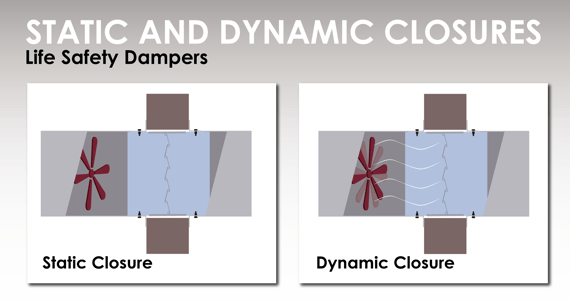
For life safety dampers, the words “static” and “dynamic” refer to the damper’s closure type. Static dampers will only close if there is no air flowing through the duct. Dynamic dampers close against airflow.
The type of damper will depend on whether system fans will shut down, remain running when an alarm is tripped, or restart as part of a smoke control system. Smoke dampers and combination fire-smoke dampers require dynamic closure, so they can close at the first signs of smoke and regardless of the fan system.
The MCDLG Newsstand
Use this article for your reference! If you have any questions on louvers or dampers, then check our other articles on the MCDLG Newsstand. We have published articles focused on louvers and dampers. At MCDLG, we strive to inform our customers so they can make knowledgeable decisions when purchasing HVAC equipment for their projects.
Are there any terms we missed? Is there anything in your specs that you don't understand? Tell us in the Comments section. We are here to help!
For more information on louvers and dampers, check out these articles on the MCDLG Newsstand:
Starting a new project? Arrow United Industries can help you find the right airflow dampers! Check out our 517 - 518 steel airfoil control dampers, built for air performance.
MCDLG is Here to Help!
Need help with your next project? Or do you have a specific question about your current projects? Talk to MCDLG! We will bring our 50+ years of experience to the table. MCDLG is here to help you.
From continuing education to equipment considerations, all the way to top-quality finished products, and to post-sales support. We assist our customers every step of the way. Interested? Read our article on all the ways we can help you: MCDLG is Here to Help!
Need help right away? Contact MCDLG today. We are ready to help you.
.webp?width=91&height=70&name=MCDLG%20Logo%20(Resize).webp)







